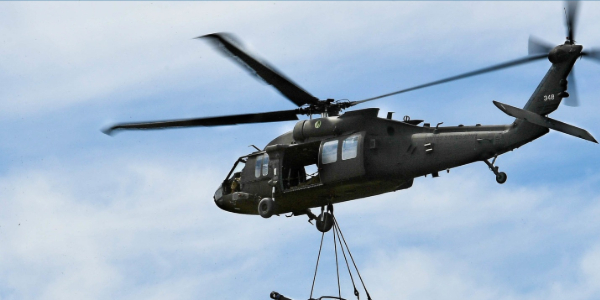Just How the Blackhawk Helicopter Ended Up Being an Icon of Military Stamina and Adaptability
Checking Out the Thrills and Innovations of the Blackhawk Helicopter
The Blackhawk helicopter stands as a testament to military aeronautics's evolution, combining technical developments with sensible applications. What exists ahead for this renowned airplane, and exactly how will arising modern technologies shape its future in army operations?
History of the Blackhawk Helicopter
Because its beginning in the 1960s, the Blackhawk helicopter has actually played an essential role in modern-day army aeronautics. Developed by Sikorsky Airplane, the UH-60 Blackhawk was made to meet the united state Military's demand for a functional utility helicopter with the ability of executing a selection of goals, including troop transportation, clinical emptying, and freight airlift. The layout was a reaction to the restrictions of earlier helicopters, particularly in terms of survivability, maneuverability, and speed.
The Blackhawk made its very first trip in 1974 and soon entered solution in 1979. Its introduction marked a significant improvement in helicopter modern technology, including a two-rotor system that improved efficiency and security. The airplane's tough building and construction and advanced avionics enabled it to run properly in diverse atmospheres and conditions.
Throughout the years, the Blackhawk has actually been continually upgraded, incorporating lessons picked up from numerous fight scenarios. Its release in disputes such as the Gulf War, Somalia, and the War on Horror additional strengthened its track record as an indispensable asset. The Blackhawk's tradition is defined by its versatility and strength, making it a foundation of military aviation for decades.
Trick Attributes and Specs
The Blackhawk helicopter is differentiated by its durable style and progressed technical functions, which jointly boost its operational capabilities. Designed primarily for utility missions, the Blackhawk boasts an optimum takeoff weight of approximately 22,000 pounds, enabling it to carry substantial hauls while maintaining dexterity.
Equipped with 2 General Electric T700-GE-701C engines, the Blackhawk achieves a maximum speed of around 183 knots and a series of 368 maritime miles - Blackhawk Helicopter. Its modern rotor system includes a four-blade primary blades and a four-blade tail rotor, guaranteeing stability and ability to move in various flying problems
The helicopter's cabin can fit as much as 11 soldiers or various cargo arrangements, showcasing versatility in objective accounts. Furthermore, the Blackhawk is created with sophisticated avionics, consisting of digital trip controls and an extensive cabin display, improving pilot situational awareness.
For improved survivability, the Blackhawk integrates ballistic armor and self-sealing gas containers. Its capability to run in varied atmospheres, from deserts to icy surfaces, further strengthens its credibility as a trustworthy system for armed forces and altruistic procedures alike. The Blackhawk's mix of strength, power, and adaptability makes it a cornerstone of modern aerial capacities.
Advancements in Technology
Advancements in innovation have considerably enhanced the capabilities of the Blackhawk helicopter, ensuring it remains at the forefront of army aviation. One of the most remarkable innovations is the assimilation of sophisticated avionics systems, which supply enhanced situational awareness with real-time data processing and display. This technology permits pilots to navigate complicated settings a lot more successfully, improving mission success prices.

Additionally, the intro of electronic fly-by-wire systems has actually revolutionized the control systems of the Blackhawk, offering smoother handling and increased responsiveness. Collectively, these technical developments ensure that the Blackhawk helicopter remains a crucial asset in contemporary army operations.
Duties in Military Workflow
With advanced innovation boosting its abilities, the Blackhawk helicopter plays a complex role in armed forces procedures. Mainly, it is used for troop transport, making it possible for rapid deployment and removal of personnel in various battle circumstances. Its roomy cabin can fit approximately 11 troops, making it an essential asset for look at this site special operations and massive goals.
Furthermore, the Blackhawk functions as a medevac system, geared up to carry wounded soldiers swiftly and effectively from the field of battle to medical centers - Blackhawk Helicopter. Its adaptability reaches logistical assistance, where it carries supplies and devices essential for sustaining military operations in remote areas

The helicopter is also important in reconnaissance missions, providing aerial security and intelligence-gathering capacities. Its capacity to operate in diverse atmospheres-- ranging from city settings to extreme terrains-- additional strengthens its importance on the battlefield.
Moreover, the Blackhawk can be equipped with innovative weapons, allowing it to involve in battle and offer close air assistance. This flexibility emphasizes the helicopter's important function in modern army approaches, making it a vital part of militaries worldwide.
Future Developments and Innovations
Advancements in innovation promise to usher in a new period for the Blackhawk helicopter, boosting its capacities and operational efficiency. Future growths for the Blackhawk may include improvements in avionics, more tips here such as innovative flight control systems and improved situational recognition devices powered by fabricated knowledge.
Additionally, the assimilation of unmanned systems is on the perspective, potentially enabling manned-unmanned teaming procedures that can expand objective accounts and lower risk to employees. The Blackhawk's design is also expected to integrate lighter and more powerful products, improving gas effectiveness and total efficiency.

Final Thought
To conclude, the Blackhawk helicopter represents a substantial success in military air travel, identified by its adaptability and advanced technical features. Its historical development mirrors a continuous action to functional needs, improving abilities in numerous duties such as army transport and medevac procedures. Recurring developments, including the integration of expert system and hybrid-electric propulsion, promise to more strengthen the Blackhawk's effectiveness and significance in future armed forces interactions, guaranteeing its standing as a vital property on the battlefield.

With advanced innovation improving its capacities, the Blackhawk helicopter plays a diverse duty in army operations. (Blackhawk Helicopter)